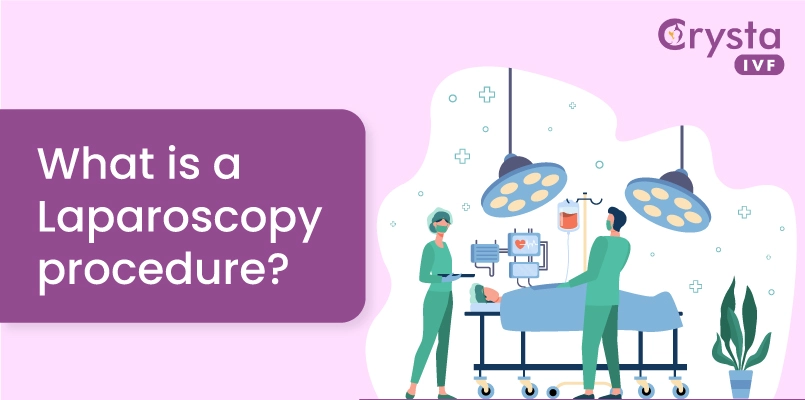About Laparoscopy
Laparoscopy, or “keyhole surgery”, is a minimally invasive technique or medical procedure that allows the assessment and viewing of the condition of inside organs, especially in the abdomen region and the female reproductive system, without any major surgery. When this procedure is a part of a fertility test for IVF Treatment.
The doctor evaluates the structure of the reproductive system, which includes ovaries, uterus & fallopian tubes.
Laparoscopy Procedure
This least invasive method of surgery utilizes a laparoscope or a wire-like thin tube that can reach inside the concerned area or organ through a very small cut in the skin, just equal to the size of a keyhole. An already connected camera to the laparoscopy captures inside images and sends these images to the computer screen through an attached monitoring device. Now, these images can be easily viewed on the screen by the surgeons for further treatment.
Hence, Laparoscopy is also called minimally invasive surgery. It is much better than traditional (open) surgery because it allows for fast recovery, a short hospital stay, minimal invasion or incision, and is less painful as well.
How is Laparoscopy Procedure done?
Generally, the procedure involves blowing carbon dioxide gas inside the organ to elevate the walls of the organ so that the inside organ view can be seen more clearly. After the procedure, the CO2 gas goes out naturally through the respiratory system.
The operation is performed under general anesthesia, so you will feel like you are in a sleeping state and will feel no pain. Small cuts (0.5–1 cm) are made in the abdomen region. A thin, flexible endoscope and other delicate instruments are then inserted through these precise incisions or cuts.
The number of incisions required depends on the severity of the disease condition, and the procedure may last only for 45 to 60 minutes without an overnight stay in the clinic or hospital.
What is it used for?
Laparoscopic surgery is useful in diagnosing abdominal symptoms like blockage, unexplained bleeding, tumor like growth, and in women, it detects endometriosis, fibroids, pelvic diseases, and ovarian cysts. Apart from this, it is also used to treat urinary incontinence, eliminate ectopic pregnancy, perform tubal ligation, and hysterectomy as well.
This surgery is used when physical exams and imaging tests, such as x-rays or ultrasounds, don’t provide enough information to make a clear diagnosis.
The Risk associated with Laparoscopy
The overall risk of laparoscopy is low. The most common side effects are skin damage and minor bleeding, which may occur in 5% (approx.) of women. Certain infections may occur in the bladder, uterus, or chest, which can be easily managed with certain medications and complete care.
There is a negligible risk of laparoscopy to the internal organs, such as the bowel or bladder, compared to conventional surgeries.
Precaution Needed Before Laparoscopy
Before the laparoscopy, you need to stop taking food or drink for six hours.
Why is a Laparoscopy Needed?
A laparoscopy is needed or advised by the physician when the CT scan or X-ray of any organ is not clear. Abdominal laparoscopy can be performed mainly in cases of injuries, blockages, infection, tumors, cancer, bleeding and abdominal pain, and for other conditions to assess the depth and site of internal injury and to see how much bleeding has occurred.
A gynecologist may also recommend laparoscopy for any female to check the fallopian tube, pelvic problems or pain, fibroids or cysts in the ovary. Most importantly, it is used to treat and check endometriosis, tie the fallopian tube, and treat ectopic pregnancy as well. Apart from these, a doctor may also suggest laparoscopy for some other conditions such as appendectomy, cholecystectomy, and taking small tissue for biopsy.
The Advantages of Laparoscopy are:
- The procedure requires a minimum number of incisions to a very small extent.
- Laparoscopic surgery is almost painless and less discomforting compared to open or invasive surgery.
- It is commonly used to treat and confirm unclear conditions or ailments.
- Laparoscopy is a very safe and effective procedure.
- It is quick to perform, so it doesn’t require an overnight or prolonged hospital stay.
- This technique allows the doctors to clearly view the condition of the inside organs of the body without major trauma.
People Also Ask
Q. Is Laparoscopy a Major Surgery?
Ans. Laparoscopy is considered a minimally invasive surgical procedure, involving small incisions and the use of a thin, lighted tube with a camera to view and potentially treat conditions within the abdomen. It is generally less invasive and requires less recovery time compared to traditional open surgeries, making it a preferred approach for many surgical interventions.
Q. How painful is Laparoscopic Surgery?
Ans. Laparoscopic surgery is generally less painful than traditional open surgery. Patients typically experience discomfort, rather than intense pain, at the incision sites. Most discomfort can be managed effectively with prescribed pain medications and usually subsides within a few days to a week after the procedure. However, individual experiences may vary depending on factors like the type of surgery, the patient’s pain tolerance, and their overall health. Always consult with your surgeon and medical team to discuss pain management and expectations specific to your case.
Q. How many stitches are in a laparoscopy?
Ans. The number of stitches used in a laparoscopy varies depending on the size and number of incisions made. Typically, one or two stitches per incision are common, but some incisions may not require stitches if they are very small. The exact number is determined by the surgeon’s judgment and the specific procedure being performed.




